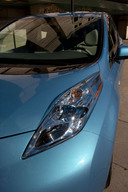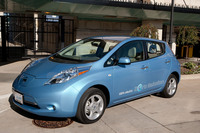2011 Nissan Leaf Zero Emission Electric Vehicle
2011 NISSAN ZERO EMISSION ALL ELECTRIC LEAF
By Bruce and Brad Hubbard
Auto Advisor Group
Nissan unveiled the all electric Zero emission LEAF August 2, 2009, a lot different than the first electric vehicle they introduced in 1947.
This ZERO emission all electric LEAF vehicle is well equipped. The 5 door hatchback has enough room for five passengers. Thanks to the flat lithium batteries and many of the items needed in a gasoline powered vehicle let the designers deliver a lot of interior space.
 |
Nissan’s LEAF is sold out and first ones will be delivered in December to just five States in North America. The Zero Emission vehicle runs well . According to Nissan the LEAF cost as low as .026 cents (average $0.11 kWh) per mile compared to gasoline (at $3 a gallon) at $0.12 per mile.
 |
 |
The Nissan LEAF has a 24kW battery pack that can be charged from your home or condo if you purchase the Level 2 Home Charging equipment from Aero Vironment as a package when you buy your LEAF. The price has been quoted at $2200.00. Your home or condo or office must be capable of supporting the power equipment. Capable of supplying a charge at 220-240V when charging on the Level 2 station. It is estimated that eight hours it will take to bring the full charge.
The LEAF's battery can also be charged at locations that install industrial level DC Fast Chargers—which can add about 80 miles of range to an electric car in under 30 minutes (80% of a LEAF's battery capacity). These DC Fast Chargers are now being installed at a locations in all of the initial LEAF launch markets. With the expensive to install DC Fast chargers you will only be able to charge 80% of the battery. If you wish to take advantage of the DC Fast Charge stations you will have to add the accessory at a price of $700. So if you order the complete package that means nearly $3000.00 for the ability to charge.
If you wish to only use the standard three prong charging system you will have to understand it takes almost 18 hours to charge. So that would be for those persons who were using the LEAF for just neighborhood driving.
Every time you coast or apply the brakes in the Nissan LEAF, the electric motor acts as an electric generator. The generator converts energy to recharge the LEAF.
With proper care and maintenance, your battery will last for many years. However, over time the lithium ion batteries will undergo some reduction in capacity. This will affect range. Consider though that 70% of people drive less than 40 miles per day. So even as your battery ages and range is affected, most people will not be impacted.
 |
“The Nissan Leaf is a perfect flag for innovation as a whole, and then it opens the road for the full communication about the brand,” Carlos Tavares, executive vice president of the Americas for Nissan and a member of Nissan’s board of directors stated.
 |
The Nissan LEAF will be available in two models. The standard SV model and the upscale SL. The higher end model is called the LEAF SL and has fog lights, rear view monitor, solar panel and rear spoiler, plus automatic on and off headlights.
 |
The interior is simple and functional. The dashboard glows with blue light. Fit and finish is excellent even on the pre-production test models. I like the way the dash and center console look. The HVAC is automatic. The audio system includes an excellent AM/FM/CD/MP3 system with MP3/WMA playback capability. The XM satellite radio and USB connection for IPod is also part of the system. Redundant controls for the sound system are located on the steering wheel. Also mounted on the tilt steering wheel are controls for the cruise control.
The first models are not offering a luxurious leather interior but all surfaces are aesthetically perfect. The driver and front passenger seats are cloth. The front seats are manually adjustable. The rear seats offer excellent headroom thanks to the sweeping roof. In fact 6 foot 3 inch passengers will love the room in the rear seating area.
 |
Nissan is not just looking at Zero emission electric vehicles to sell worldwide. They already have diesel vehicles in other parts of the world and Carlos announced they plan on bringing diesel vehicles to the North American market. The German’s have had great success with the newest diesels for years. Nissan will continue to produce high performance and efficient direct injection gasoline vehicles.
 |
Nissan expects that electric vehicles will account for 10% of global sales and 6.5% of U.S. sales by 2020. The 2011 Chevrolet Volt, which will reach consumers this month, also will depend on tax credits, at least for initial consumer acceptance. It has a starting price of about $41,000 before the $7,500 tax credit. The Volt goes about 40 miles on battery power before it switches over to a gas generator that can power the car for up to an additional 260 miles. California has denied them a tax credit for they feel it is not a true electric vehicle.
Right now Mitsubishi, Smart Car, Mini E have vehicles they are testing to bring to market that will be all electric. MINI E I drove was smaller than the regular mini for the batteries took up the entire back seat. Mini’s field trials and the 450 vehicles is helping them develop a vehicle that will be sold or leased. Nissan is the first to actually offer a compact vehicle that has been sold and will be serviced by it’s dealerships.
Down the road Nissan may even have rental stations in certain markets that will allow persons to rent for the day. Nissan’s future in the Zero emissions electric vehicles has only begun.
Nissan New Mobility Concept vehicle is a small transporter that can travel 62 miles with top speed of 47 mph. The vehicle is being seen presently around amusement parks in Yokohama City’s green mobility project. The vehicle was designed in conjunction with Renault..



